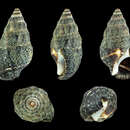Comprehensive Description
(
Inglês
)
fornecido por Smithsonian Contributions to Zoology
Clypeomorus irrorata (Gould)
Cerithium irrorata Gould, 1849:119 [holotype: USNM5568; paratype: MCZ 169206; type-locality, here designated: Looc Bay, Bataan, Luzon, Philippines; not Cerithium irrorata C.B. Adams, 1852]; 1852:148; 1856, pl. 10: fig. 168.—Johnson, 1964:94.
Cerithium obesum Sowerby, 1855:868, pl. 181: figs. 141–142 [lectotype: BMNH, not registered; type-locality: Bohol, Philippines; not Cerithium obesum Deshayes, 1834; nor Gabb, 1873 (in part); nor Guppy, 1876]; 1865: pl. 9: fig. 62.—Martens, 1897:175.—Tesch, 1920:56, pl. 131: fig. 181.—Oostingh, 1925:45.
Cerithium repletulum Bayle, 1880:248 [new name for Cerithium obesum Sowerby, 1855].—Tryon, 1887:139, pl. 26; fig. 92.—Kobelt, 1895:186–187, pl. 34: fig. 9.
DESCRIPTION.—Shell (Figure 44; Table 26): Shell thick, having teleoconch of 8 or 9 whorls, apical angle of 45 degrees, and reaching 15.5 mm in length. Early juvenile whorls and protoconch usually eroded or decollate. Length/width index of 2.27. Whorls sculptured with 9–15 broad wavy axial ribs, and with many fine flattened spiral threads and numerous, spiral microscopic incised lines. Body whorl wide, inflated, about one-half the length of the shell. Axial ribs on body whorl plicate, and limited to upper third of whorl adjacent to suture. Shell depressed between axial plications on body whorl. Lower two-thirds of body whorl lack axial sculpture, having only spiral elements present. Body whorl slightly constricted at base. Aperture ovate, about one-third the shell length. Anterior siphonal canal short, deep, slightly turned at a 45 degree angle to shell axis. Anal canal deep, extending into shell aperture, bordered by posterior columellar tooth. Columella concave with thickened callus extending at parietal area onto lower fourth of penultimate whorl. Outer lip rounded, smooth, thick, and interiorly lirate. Thick varix along edge of outer lip. Upper edge of outer lip partially extends onto penultimate whorl. Plane of outer lip parallel to shell axis. Entire aperture heavily enameled. Suture incised, wavy. Protoconch unknown. Shell color variable, normally white, brown, or gray, overlain by numerous thin spiral dotted lines of brown and black. Entire shell sometimes black. Periostracum thin, light brown, frequently eroded on most of shell. Operculum thin, corneous, ovate, and paucispiral with subcentral nucleus adjacent to anterior siphonal canal.
Radula (Figure 45; Table 27): Radular ribbon long, about 7.5 mm in length and having 139 rows of teeth. Shell length/radula length index 2.54. Rachdian tooth (Figure 45d) squarish, about 55 μm wide, with deep dorsal median depression. Cutting edge of rachidian tooth bears large flat chisel-like medial cusp flanked on each side by small peg-like denticle. Basal plate of rachidian tooth flat, with long pointed central glabrella originating at its center and extending, buttress-like, below base. Base of rachidian tooth slightly convex with 2 small pointed lateral ends. Lateral tooth (Figure 45c) trapezoidal having dorsal moderately convex, cutting edge bearing large shovel-like cusp flanked on each side with small pointed denticle. Basal plate of lateral tooth with long tapering basolateral projection, which twists where it is inserted onto radular membrane. Blunt basolateral median projection extends ventrally to cutting edge. Marginal teeth (Figure 45b) long, wide, curved, spatulate, and wide at tips. Tip of inner marginal tooth bears median wide scoop-like cusp flanked on each side with small pointed denticle. Outer marginal tooth identical, only lacking outer denticle.
Animal: Head-foot and short snout dark colored, lined with numerous fine transverse dark lines. Tentacles dark brown, each with large eye at base of peduncular stalk. Sole of foot cream colored. Mantle edge cream colored, with fine transparent papillae separated from each other by yellow pigmented area. Interior of inhalant siphon bright yellow, divided longitudinally with thin septum attached to mantle roof, but free distally. Ctenidium pink-brown, bipectinate osphradium dark brown and thick hypobranchial gland whitish. Kidney bright purple, stomach yellow, digestive gland brown and gonads yellow or cream. Pallial oviduct has long shallow sperm gutter beginning at distal end of medial lamina and ending postmedianly in large spermatophore bursa located in proximal half of the lamina. No seminal receptacle seen. Stomach large, long crystalline style present.
MATERIAL EXAMINED.—CEYLON: (ANSP 247909). SINGAPORE: Tanjong Gulf (USNM 631931, ANSP 239554). THAILAND: Si Racha, Gulf of Siam (USNM 774501). INDONESIA: Batavia Bay, Java (ZMA); Amsterdam, Middelburg, Leiden and Hoorn Ids, Djakarta Bay, Java (ZMA); Bali (AMS); Kudat Bay, N. Borneo (USNM 632239); Telok Slawi, Komodo Id, Lesser Sunda Islands (UF 24760). AUSTRALIA: Low Isles, NE of Port Douglas, Queensland (AMS C114876; AMS 117188). NEW GUINEA: Wandamen Bay, West Irian (ZMA); Japen Id, Schouten Ids, West Irian (AMS); N shore of Maroepi Id, Ambai Ids, West Irian (ANSP 208535). PHILIPPINES: Matabungbay, 115 km SSW of Manila, Luzon (AMS); Eman Pt, Morong, Bataan, Luzon (USNM 774753); Eman Pt, Morong, Bataan, Luzon (USNM 774753); Jamelo Bay, Luzon (USNM 243948); Butananan Id, E. Luzon (USNM 233004); Palaui Id, W coast, Luzon (USNM 232925); coast of Mariveles, Luzon (USNM 303681); Canmahana Bay, Ragay Gulf, Luzon (USNM 239731); Luzon (USNM 243616); Busuanga, Bintnan Id, Calamian Gp (USNM 233014); Coron, Bintuan Id, Calamian Gp (USNM); Puerto Princessa, Palawan (ANSP 224591, 272422); Bolalo Bay, Palawan (USNM 243689, 243692); Tagbayug Bay, Palawan (USNM 244186, 244189); Ulugan Bay near Caiholo River, Palawan (USNM 239915, 243945); Malcochin Harbor, Linapacan Id, Palawan (USNM 243857, 243858); Estero Pt, Sablayan Bay, Mindoro (USNM 232839); Tilik, Lubang Id (USNM 229917); Catbalogan, Samar (USNM 232951); San Pascual, Burias (USNM 239950); Guiljungan, Negros (USNM 232854, 24405); Enrique Villanueva, Siquijor Id (USNM 774492); Mactan Id, Cebu (USNM 244038); Malabuyoc, Cebu (USNM 774586, AMNH 121935, CAS 39494); 12 km N Cebu at Tayud, Cebu (UF 30347); Sarangani Id, Sarangani Bay, Mindanao (USNM 233131); 22 km N Lupou, Tagdado, Banay, Banay Dist, Mangapa Bay, Davao, Mindanao (UF 30567); Malabang, Mindanao (USNM 233143); Tictauan Id, Mindanao (USNM 243829). RYUKYU ISLANDS: Shioya, Shanawan Bay, Okinawa (USNM 774500); Osima, Osumi (USNM 343866).
- citação bibliográfica
- Houbrick, Richard S. 1985. "Genus Clypeomorus Jousseaume (Cerithiidae: Prosobranchia)." Smithsonian Contributions to Zoology. 1-131. https://doi.org/10.5479/si.00810282.403

